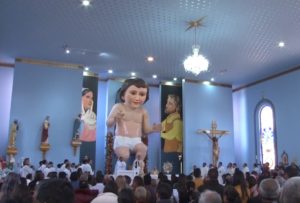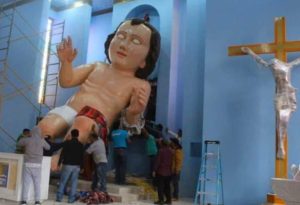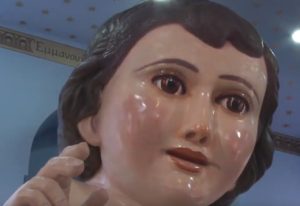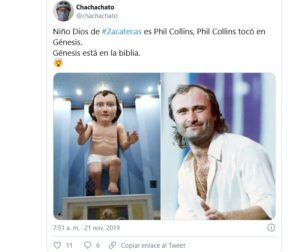Podcast: Play in new window | Download
Subscribe: Apple Podcasts | RSS
 “Congratulations Zóquite and congratulations to the Christian communities that form this parish. I know this place will become famous around the world thanks to your fiesta, thanks to this image which represents your faith, your eternal great faith.”
“Congratulations Zóquite and congratulations to the Christian communities that form this parish. I know this place will become famous around the world thanks to your fiesta, thanks to this image which represents your faith, your eternal great faith.”
Thus spoke Sigifredo Noriega Barceló, Archbishop of Zacatecas on January 6, 2020 on the Feast of the Epiphany, also known as “Tres Reyes” in Mexico. The holiday – observed to honor the arrival of the Three Wise Men in Bethlehem – usually marks the end of the Christmas season in most Latin American countries. This special celebration in the town of Zóquite, however, marked a new beginning for the town, in a sense. The archbishop of Zacatecas led the religious festivities for this small parish in part to bless formally the installation of the largest Baby Jesus sculpture the world has ever seen.
The Spanish came to the region surrounding the town of Zóquite in the mid-1500s when silver was discovered nearby. At the time of European contact, the town had already been established as an indigenous village with several hundred people living there. The town’s name derives from the Nahuatl word zoquitl which means “mud.” “Zóquite” means, “a place where there is no mud,” owing to the arid conditions of the surrounding countryside. The town has 4,300 inhabitants and is located in the Mexican state of Zacatecas about 14 miles east of the state capital near Zacatecas’ border with the state of San Luis Potosí. In 2008 the Catholic Church established the parish of Our Lord of the Epiphany in Zóquite to serve the communities of Santa Mónica, La Blanquita and Colonia Osiris. With this new parish, the construction of a new church was not far behind. With the enthusiasm and dedicated energy of parish priest Father Manuel Haro Campos, the parishioners raised 6 million pesos for the building project which was the biggest such endeavor the town had seen in many years. The following year, 2009, Zóquite had a brand-new church, called in Spanish, El Templo de la Epifania del Señor. The enthusiasm built up around the new church did not end when masons fitted the last stone in its place in this templo. The parishioners wanted to make their new church a special place, a site that would draw outside visitors, including pilgrims and tourists. Less than 45 minutes from Zóquite is a major Mexican pilgrimage site at the town of Plateros just north of the capital city of Zacatecas where a statue of the seated Christ Child is venerated, drawing millions of visitors per year. For more information about the Santo Niño de Plateros, please see Mexico Unexplained Episode 192. https://mexicounexplained.com//the-santo-nino-and-the-miracles-at-plateros/ Perhaps hoping to get some spillover from the other Santo Niño site, the people of the new parish in Zóquite came up with an idea to put themselves on the map: they would create the largest sculpture of the Baby Jesus found anywhere in the world and house it in their new church.
 It wasn’t difficult to research their competition. In the year 2014 a parish in the city of Nezahualcóyotl in the Mexican state of México shared with the world a massive, blue-eyed Baby Jesus sculpture that measured sixteen and a half feet long and weighed over 1,100 pounds. Mayor of Nezahualcóyotl Juan Hugo de la Rosa García bragged that this Santo Niño would be in the Guinness Book of World Records because it beat the largest Baby Jesus sculpture in the world, found in Germany, by about two and a half feet. The people of Zóquite watched all of this unfold and took notes.
It wasn’t difficult to research their competition. In the year 2014 a parish in the city of Nezahualcóyotl in the Mexican state of México shared with the world a massive, blue-eyed Baby Jesus sculpture that measured sixteen and a half feet long and weighed over 1,100 pounds. Mayor of Nezahualcóyotl Juan Hugo de la Rosa García bragged that this Santo Niño would be in the Guinness Book of World Records because it beat the largest Baby Jesus sculpture in the world, found in Germany, by about two and a half feet. The people of Zóquite watched all of this unfold and took notes.
The parishioners in this small Zacatecas town started fundraising again with the same zeal they had when raising money for their new church. This time they gathered together 218,800 pesos for the creation of their own gigantic Baby Jesus sculpture, the biggest of them all. To make the statue, they commissioned an artist named Román Salvador Barrueto who has his workshop in the town of Chimalhuacán in the Mexican state of México some 375 miles away from the Church of Our Lord of the Epiphany in Zóquite. Barrueto and his team of craftsmen spent months creating this colossal Christ Child starting with a metal frame and mesh and then covering it all with silica sand, ceramic pastes and resins. The final product was a 21 ½-foot long, 1,700-pound giant. It traveled the 375 from Barrueto’s workshop on the back of a flatbed truck with its arms detached. When it arrived at Zóquite on November 13, 2019, it took 12 men to unload this massive religious icon and bring it to the altar section of the church. There, local artists attached the arms and put the finishing touches on this sculpture that looks, at first glance, like a gigantic baby in diapers. The Zóquite artists added color to the Santo Niño’s cheeks and then painted his eyes blue. Under objections from some people in charge of the project, the eye color was repainted to a coffee-color brown. With the finishing touches complete, it took 20 men to screw the 1,700-pound sculpture to the wall behind the altar. Zóquite artist Hilario Fuentes then painted pictures on either side of the gigantic Baby Jesus. Facing the sculpture to the right is the baby’s earthly father, Joseph, wearing a carpenter’s apron over a golden-colored shirt. The left side features a painting of the Virgin Mary with a stern but somewhat perplexed expression on her face. Fuentes also painted the Three Wise Men on the wall of the church.
 The enthronement of this huge Baby Jesus by the archbishop of Zacatecas in early January 2020 seemed like a good start for this monumental undertaking that took years of planning and effort. Visitors started coming to Zóquite as expected and things were going better than hoped as the economic ripple effect was felt positively throughout the town. A few months after the dedication, however, the church was closed to visitors due to COVID-19. With less travel even after some of the restrictions were lifted, the oversized Santo Niño has not been receiving the adoration and veneration the locals had initially expected. Despite the lull in visitors, parishioners and others in the surrounding areas have been praying to this new Christ Child and have claimed that he has answered prayers and worked miracles. The town of Zóquite has endured little sickness and death from the global pandemic and many credit the protection of the Santo Niño for this. In an interview with a Zacatecas television station a Zóquite resident claimed that the statue serves as a reminder of when Christ was the most vulnerable, when he was a little baby, and faith in this powerful image helps protect the most vulnerable among us from disease or from any other of life’s maladies and misfortunes.
The enthronement of this huge Baby Jesus by the archbishop of Zacatecas in early January 2020 seemed like a good start for this monumental undertaking that took years of planning and effort. Visitors started coming to Zóquite as expected and things were going better than hoped as the economic ripple effect was felt positively throughout the town. A few months after the dedication, however, the church was closed to visitors due to COVID-19. With less travel even after some of the restrictions were lifted, the oversized Santo Niño has not been receiving the adoration and veneration the locals had initially expected. Despite the lull in visitors, parishioners and others in the surrounding areas have been praying to this new Christ Child and have claimed that he has answered prayers and worked miracles. The town of Zóquite has endured little sickness and death from the global pandemic and many credit the protection of the Santo Niño for this. In an interview with a Zacatecas television station a Zóquite resident claimed that the statue serves as a reminder of when Christ was the most vulnerable, when he was a little baby, and faith in this powerful image helps protect the most vulnerable among us from disease or from any other of life’s maladies and misfortunes.
 Seriousness aside, when news of the “Gigantic Baby Jesus of Zóquite” hit the internet, the largest Christ Child statue in the world became the butt of jokes and the subject of many memes. Some claimed that the face of the sculpture looked eerily similar to that of the British musician Phil Collins or to American actor Nicholas Cage. To others, the face of the Baby Jesus, along with his posture and outstretched arms, were reminiscent of deceased Mexican wrestler Perro Aguayo. A conspiracy theory arose claiming that the sculptor played a joke on the town when he fashioned this massive icon to look like the famous former luchador who was one of his personal favorites. Other memes pair the statue with Godzilla and Rodan attacking Tokyo or some other major city. Some internet commenters also compared the likeness of the gigantic Baby Jesus to that of Chucky, the evil hell doll from the American horror film series “Childsplay.” There seems no end to the creative showcasing of the human imagination online these days.
Seriousness aside, when news of the “Gigantic Baby Jesus of Zóquite” hit the internet, the largest Christ Child statue in the world became the butt of jokes and the subject of many memes. Some claimed that the face of the sculpture looked eerily similar to that of the British musician Phil Collins or to American actor Nicholas Cage. To others, the face of the Baby Jesus, along with his posture and outstretched arms, were reminiscent of deceased Mexican wrestler Perro Aguayo. A conspiracy theory arose claiming that the sculptor played a joke on the town when he fashioned this massive icon to look like the famous former luchador who was one of his personal favorites. Other memes pair the statue with Godzilla and Rodan attacking Tokyo or some other major city. Some internet commenters also compared the likeness of the gigantic Baby Jesus to that of Chucky, the evil hell doll from the American horror film series “Childsplay.” There seems no end to the creative showcasing of the human imagination online these days.
As more restrictions are lifted and as more miracles are attributed to the Santo Niño Gigante of Zóquite, perhaps the town may become one of Mexico’s main pilgrimage sites attracting the curious, the faithful and those desperate for some sort of divine interventions in their lives. Only time will tell.
REFERENCES
“La historia del nino Dios mas grande del mundo puesto en Zacatecas,” In Milenio, 21 Nov. 2019. (Spanish)
Sachina, Manjuamud. “Conoce aqui la verdadera historia del Nino Dios Gigante de Zacatecas,” In El Sol de Zacatecas, 21 Nov. 2019. (Spanish)
